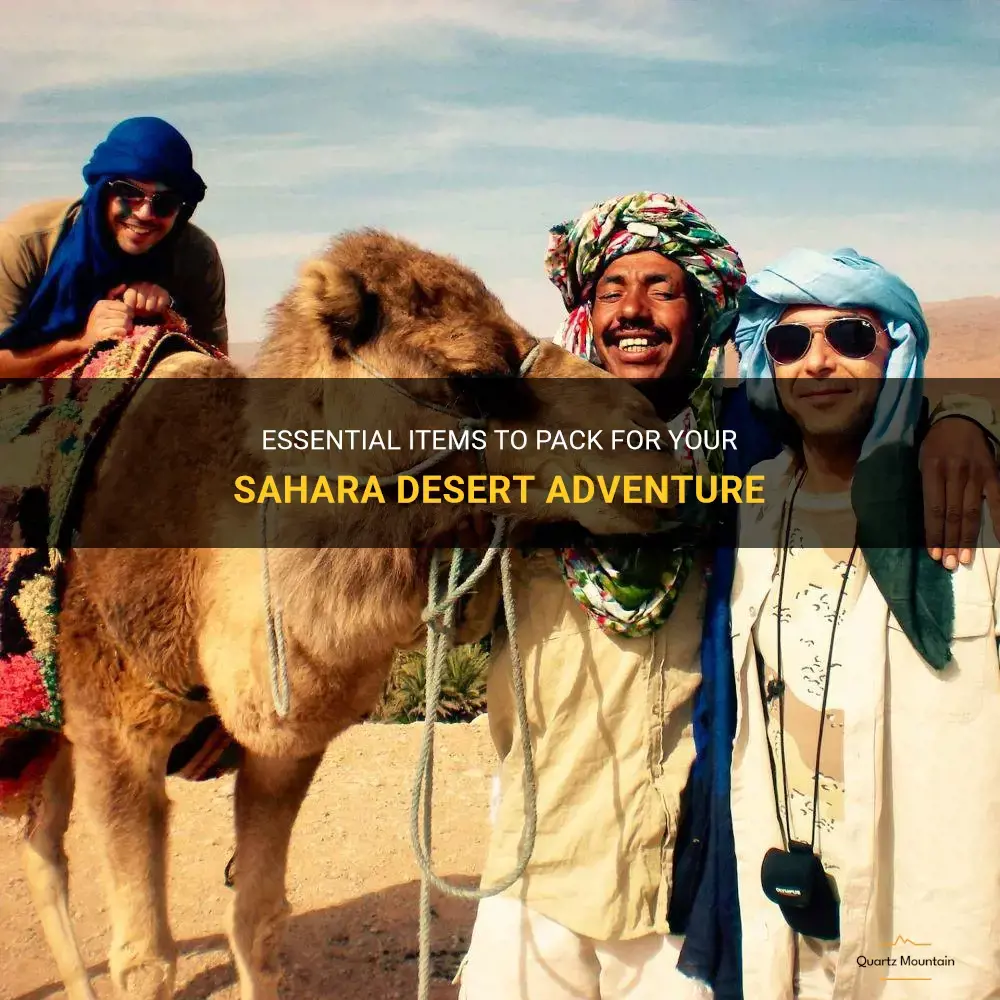
Are you planning a once-in-a-lifetime adventure to the breathtaking Sahara Desert? This vast expanse of sand and dunes is not only a stunning natural wonder but also an unforgiving environment. To ensure that your journey is safe and enjoyable, it is crucial to pack the essential items for your trip. From adequate clothing to essential equipment, we have compiled a comprehensive list of items that will make your Sahara Desert adventure an unforgettable experience. So, let's gear up and explore the wonders of this mesmerizing desert!
What You'll Learn
- What essential items should be included in a packing list for a trip to the Sahara desert?
- Are there any specific clothing recommendations for traveling in the extreme heat of the Sahara desert?
- What type of footwear is recommended for exploring the Sahara desert?
- Are there any specific items or supplies that are necessary for camping in the Sahara desert?
- What essential medical supplies or medications should be included in a first aid kit for a trip to the Sahara desert?

What essential items should be included in a packing list for a trip to the Sahara desert?

If you are planning a trip to the Sahara desert, it is important to be prepared and pack the right items to ensure your safety and comfort during your adventure. The Sahara desert is one of the harshest environments on Earth, with extreme temperatures, limited water resources, and harsh terrain. Here are some essential items that should be included in your packing list for a trip to the Sahara desert:
- Water: Staying hydrated is critical in the desert. Make sure to carry enough water to last you the entire trip, as there may not be any easily accessible water sources along the way. It is recommended to bring at least one gallon (3.8 liters) of water per person per day.
- Sun protection: The Sahara desert is known for its scorching sun, so protecting your skin from sunburn and other harmful effects of UV rays is crucial. Pack sunscreen with a high SPF, wide-brimmed hats, long-sleeved shirts, and lightweight, breathable clothing that covers your arms and legs.
- Camping gear: If you plan to spend the night in the desert, it is important to bring the necessary camping gear. This includes a sturdy tent that can withstand the strong desert winds and sandstorms, sleeping bags suitable for extreme temperatures, sleeping pads or air mattresses for insulation from the cold ground, and a portable camping stove for cooking.
- Navigation tools: The desert can be disorienting, with vast stretches of sand and dunes that all look the same. It is essential to have proper navigation tools to help you find your way. Bring a reliable compass, a map of the area, and a GPS device with preloaded maps.
- Clothing: Pack lightweight, loose-fitting clothing that can shield you from the harsh desert conditions. Opt for breathable fabrics that can wick away sweat and keep you cool. Remember to pack enough clothing for the duration of your trip, as laundry facilities may not be available.
- Desert footwear: Choose sturdy, closed-toe shoes or boots that provide good ankle support and protection from sharp rocks, scorpions, and other desert hazards. Avoid sandals or flip-flops, as they offer little protection.
- First aid kit: Accidents can happen anywhere, and being prepared for medical emergencies is essential. Pack a well-stocked first aid kit that includes bandages, antiseptic ointment, pain relievers, antidiarrheal medication, and any personal medications you may need.
- Food and snacks: Carry enough food to sustain you throughout your trip, as there may not be any food sources in the desert. Opt for non-perishable items that are easy to prepare and provide high energy, such as granola bars, nuts, dried fruits, and canned goods.
- Communication devices: In case of emergencies or getting lost, it is important to have a means of communication with the outside world. Pack a fully charged cell phone, a portable charger, and consider investing in a satellite phone or two-way radio for remote areas with limited cell coverage.
- Extra supplies: It is always wise to pack extra supplies in case of unexpected situations or delays. Include items such as extra batteries, water purification tablets, a multi-tool, a whistle, a flashlight, a fire starter, and a sturdy backpack to carry all your essentials.
In conclusion, a trip to the Sahara desert requires careful planning and packing of essential items to ensure your safety and comfort. Staying hydrated, protecting yourself from the sun, having proper navigation tools, and bringing the necessary camping gear are all crucial for a successful and enjoyable experience in the Sahara. Remember to check the local weather conditions and consult with experienced desert travelers for additional advice on what to pack.
The Essential Packing Guide for a September Visit to France
You may want to see also

Are there any specific clothing recommendations for traveling in the extreme heat of the Sahara desert?
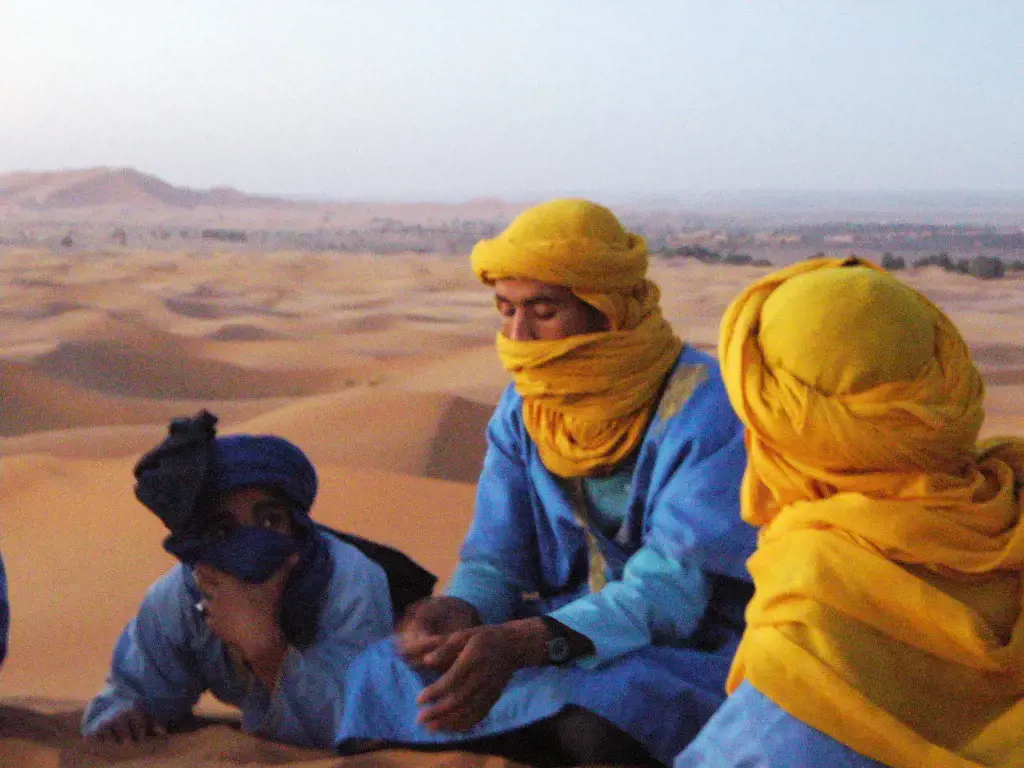
Traveling in the extreme heat of the Sahara desert requires careful consideration of clothing choices. The extreme temperatures, reaching up to 50 degrees Celsius (122 degrees Fahrenheit), can be a challenge to navigate, and it is vital to prioritize comfort and protection from the sun. Here are some specific clothing recommendations to keep in mind for your trip to the Sahara desert:
- Lightweight and breathable fabrics: Choose clothing made of lightweight materials like cotton or linen that allow air circulation and aid in sweat evaporation. Avoid synthetic fabrics like polyester, as they tend to trap heat and moisture, making you feel even hotter.
- Loose-fitting garments: Opt for loose-fitting clothing to maintain airflow and allow your body to cool naturally through evaporation. Tight or constricting clothes can hinder this process and make you feel suffocated in the scorching heat.
- Long-sleeved shirts and pants: Despite the instinct to wear less clothing in hot weather, it is recommended to cover up as much as possible to protect your skin from the intense sun rays. Long-sleeved shirts and pants made of lightweight fabrics help shield your skin from the sun and reduce sunburn risk.
- Light-colored clothing: Choose light-colored clothing, preferably in white or pastel shades, as they reflect sunlight rather than absorbing it. Dark colors tend to absorb heat, making you feel hotter.
- Headgear and sunglasses: Protect your head and face by wearing a wide-brimmed hat or a lightweight scarf to shield yourself from direct sunlight. Additionally, wear sunglasses to protect your eyes from harmful UV rays and minimize the risk of eye strain caused by the glare of the desert.
- Quality footwear: Opt for sturdy and comfortable closed-toe shoes or boots that offer protection from sharp rocks, scorching sand, and potential snakebites. Make sure your footwear is breathable and has good arch support to prevent discomfort or blisters.
- Thermal wear for colder evenings: While the Sahara desert is known for its extreme heat during the day, temperatures can drop significantly during the night. Pack a lightweight thermal layer or a jacket to keep you warm during the cooler evenings.
- Sunscreen and insect repellent: Besides clothing, it is essential to wear sunscreen with a high sun protection factor (SPF) to protect your skin from harmful UV rays. Additionally, don't forget to bring insect repellent to ward off mosquitoes and other biting insects that can be found in the desert.
When traveling in the Sahara desert, it’s crucial to prioritize your comfort, protection, and safety. By following these clothing recommendations, you can stay cool, shielded from the sun, and fully enjoy your desert adventure without compromising your well-being.
Essential Items to Pack for Okeechobee Music & Arts Festival
You may want to see also

What type of footwear is recommended for exploring the Sahara desert?
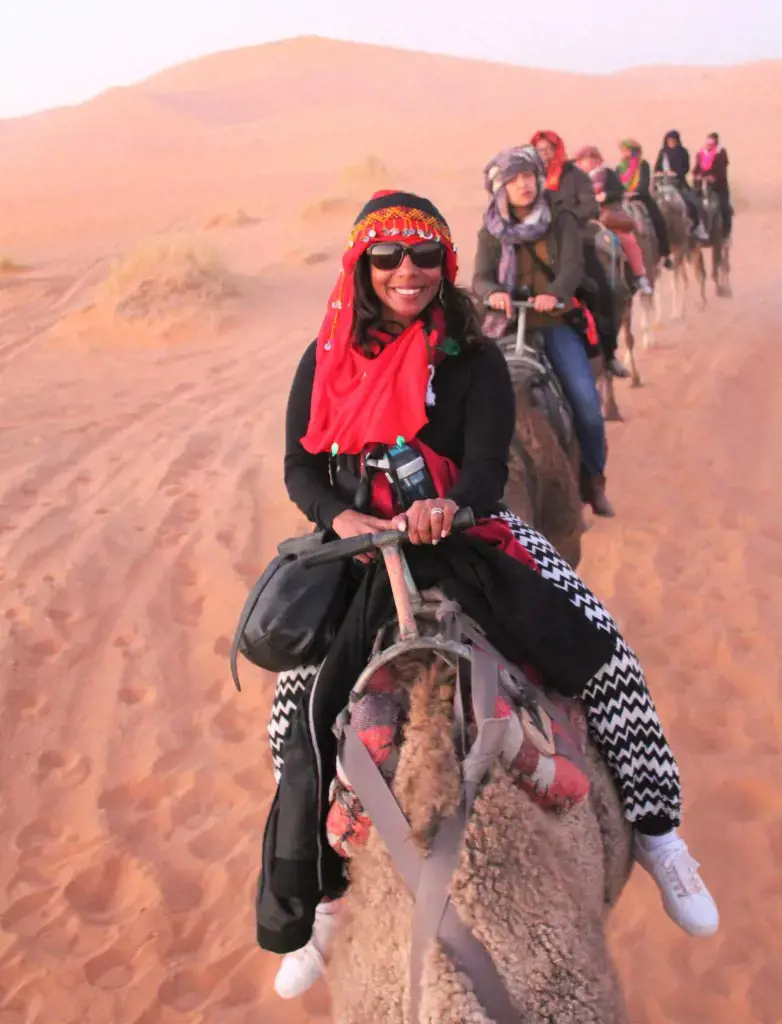
When it comes to exploring the Sahara desert, proper footwear is of utmost importance. The desert terrain can be challenging, with its vast stretches of sand, rocks, and extreme temperatures. To ensure a comfortable and safe experience, it is crucial to choose the right footwear for your desert adventure.
The most recommended type of footwear for exploring the Sahara desert is a good pair of closed-toe hiking boots. These boots provide excellent ankle support, which is essential for navigating uneven surfaces and preventing injuries. Look for boots with a sturdy and well-gripped sole to ensure good traction on sand and rocky terrain.
It is also important to consider the material of the boots. Opt for boots made of breathable and lightweight materials, such as leather or synthetic fabrics. The desert heat can be intense, and heavy boots can quickly become uncomfortable and lead to excessive sweating. Additionally, choose boots that are water-resistant or waterproof to protect your feet from sand, dust, and potential water crossings.
Before embarking on your desert adventure, it is advisable to break-in your boots. This involves wearing them for shorter hikes or walks to allow your feet to adjust to the boots and avoid blisters or discomfort during your Sahara exploration. It is also essential to ensure that your boots fit properly, providing enough room for your toes to wiggle but snug enough to prevent excessive sliding and blisters.
In addition to suitable footwear, it is recommended to pack a few other essential items to make your Sahara exploration more comfortable. Invest in a good pair of moisture-wicking socks to keep your feet dry and prevent blisters. These socks are made of synthetic materials designed to draw moisture away from the skin. Bring along extra pairs to change into if needed.
Furthermore, consider using gaiters to protect your lower legs and ankles from sand, rocks, and other debris. Gaiters are worn over your boots and lower legs, forming a barrier that prevents dust and small stones from getting into your shoes. They are particularly useful in sandy environments like the Sahara desert.
Lastly, don't forget to bring along a pair of lightweight sandals or flip-flops for campsite use. After a long day of trekking in your hiking boots, your feet will appreciate the opportunity to breathe and relax in more breathable footwear. Sandals are also useful for river crossings or when you encounter areas with softer sand that might be challenging to navigate in boots.
In conclusion, when exploring the Sahara desert, it is crucial to choose footwear that provides ankle support, is breathable and lightweight, and has a good grip on various terrains. Closed-toe hiking boots are the most recommended type of footwear for Sahara expeditions. Additionally, consider wearing moisture-wicking socks, using gaiters for added protection, and bringing along lightweight sandals for campsite use. By wearing the right footwear, you can ensure a comfortable and safe experience while exploring the mesmerizing beauty of the Sahara desert.
The Ultimate Packing Guide for a Relaxing Vacation in Myrtle Beach
You may want to see also

Are there any specific items or supplies that are necessary for camping in the Sahara desert?
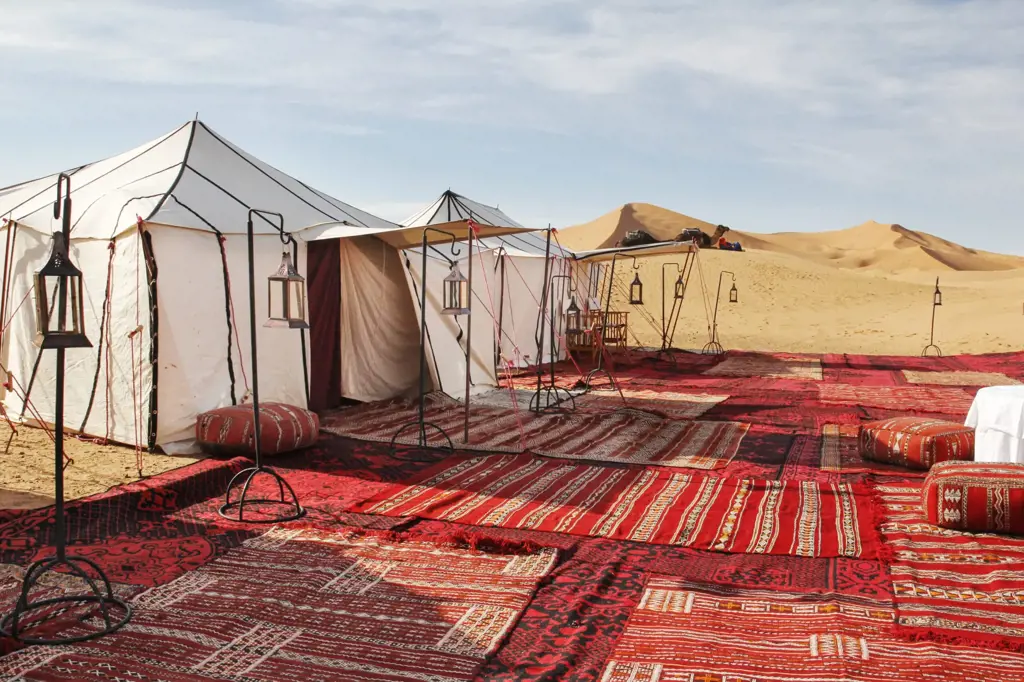
Camping in the Sahara desert is an exhilarating experience unlike any other, but it also requires careful preparation and planning. When venturing into this unforgiving environment, there are specific items and supplies that are necessary to ensure your safety and enjoyment. In this article, we will explore some of the essential gear needed for camping in the Sahara desert.
First and foremost, it is crucial to have a good quality tent that can withstand the harsh conditions of the desert. Look for a tent with a sturdy frame, durable materials, and a design that offers protection from strong winds and blowing sand. A tent with proper ventilation is also important to combat the extreme heat during the day and the cold temperatures at night.
In addition to a tent, you will need a high-quality sleeping bag and sleeping pad to ensure a comfortable night's sleep. The Sahara desert can experience drastic temperature changes, with scorching hot days and chilly nights. Opt for a sleeping bag that is suitable for the temperature range you expect to encounter and a sleeping pad that provides insulation from the cold desert ground.
When camping in the Sahara desert, it is essential to have a sufficient water supply. The desert is an arid environment with little to no natural sources of water. Pack enough water to last throughout your camping trip, as well as some extra for emergencies. It is recommended to carry at least one gallon of water per person per day. Additionally, bring a water filtration system or purification tablets to treat water from local sources if necessary.
The Sahara desert is known for its intense sunlight and extreme temperatures. Protecting yourself from the sun's harmful rays and preventing heat-related illnesses is crucial. Bring a wide-brimmed hat, sunglasses, and sunscreen with a high SPF. Lightweight, loose-fitting clothing made from breathable materials like cotton or linen is ideal for keeping cool. Don't forget to bring a light jacket or sweater for the cooler evenings.
When it comes to footwear, sturdy and comfortable hiking boots or closed-toe sandals are a must. The desert terrain can be rocky, sandy, and uneven, so having proper footwear will protect your feet from injury and offer better stability and traction. Additionally, pack a pair of flip-flops or lightweight shoes for relaxing in the campsite.
Other essential items for camping in the Sahara desert include a reliable navigation system such as a compass and a detailed map, a first aid kit, a flashlight or headlamp with extra batteries, a multi-tool, fire starter, and insect repellent. It is also wise to bring a satellite phone or a reliable means of communication in case of an emergency.
Finally, it is important to respect the fragile desert ecosystem and leave no trace behind. Bring biodegradable soap for washing dishes and personal hygiene, pack out all trash, and minimize your impact on the environment.
Camping in the Sahara desert offers a unique and unforgettable experience, but it requires thorough preparation and the right gear. By having the necessary items and supplies, you can ensure your safety, comfort, and enjoyment while exploring this breathtaking wilderness. Remember to plan ahead, be prepared for the desert's challenges, and make unforgettable memories in this remarkable environment.
Essential Items to Pack for Study Abroad in Greece
You may want to see also

What essential medical supplies or medications should be included in a first aid kit for a trip to the Sahara desert?
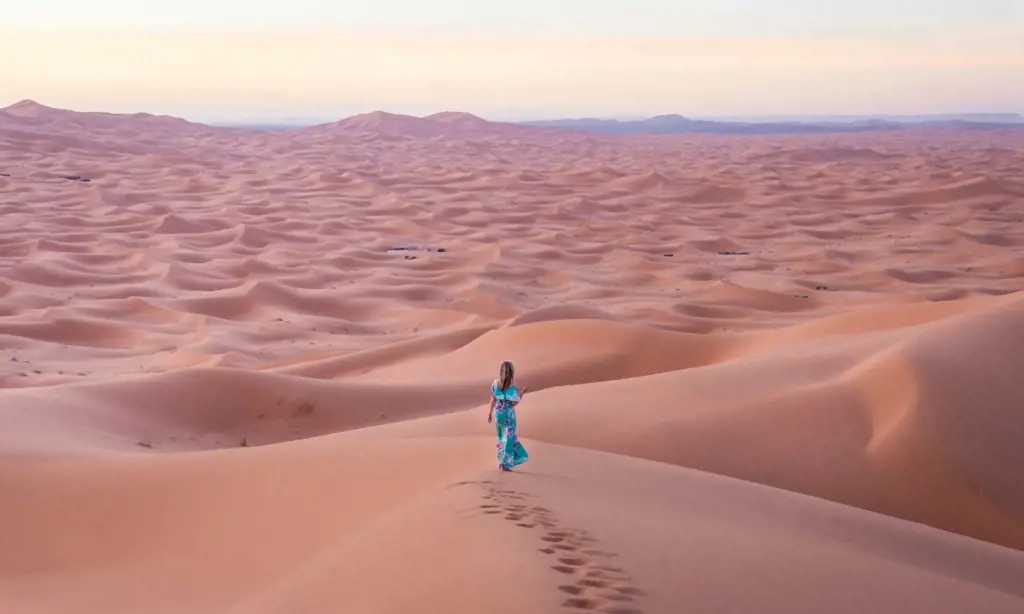
A trip to the Sahara desert can be an exciting adventure, but it's important to be prepared for any potential medical emergencies. When it comes to packing a first aid kit for such a trip, there are several essential supplies and medications that should be included.
- Bandages and Dressings: It's important to have an assortment of bandages and dressings in your first aid kit to treat any cuts, scrapes, or blisters that may occur. These should include adhesive bandages of various sizes, sterile gauze pads, and adhesive tape.
- Antiseptic Solution: In the desert, the risk of infection is high due to the lack of clean water and the presence of sand and dust. Include an antiseptic solution such as hydrogen peroxide or iodine to clean wounds and prevent infection.
- Pain Relievers: Ibuprofen or acetaminophen should be included in your first aid kit to alleviate pain and reduce fever. These can be helpful for headaches, muscle aches, or any pain caused by the extreme heat or physical exertion.
- Antihistamines: With the desert comes the risk of insect bites, allergies, or allergic reactions to dust and pollen. Including antihistamines such as diphenhydramine can help alleviate allergic symptoms like itching, swelling, or hives.
- Sunburn Relief: The Sahara desert is known for its intense sunlight, and sunburn can be a common occurrence. Pack aloe vera gel or a sunburn relief cream to soothe and heal sunburned skin.
- Eye Drops: In the dry and dusty conditions of the desert, eye irritation can be a frequent problem. It's advisable to carry lubricant eye drops to relieve dryness and irritation.
- Diarrhea Medication: Traveler's diarrhea is a common problem in many parts of the world, including desert regions. Include over-the-counter medication such as loperamide to manage symptoms and prevent dehydration.
- Rehydration Salts: Dehydration can occur quickly in the desert due to the hot and dry conditions. Including oral rehydration salts in your first aid kit is essential to replenish electrolytes and prevent dehydration.
- Prescription Medications: If you have any pre-existing medical conditions or take regular medications, make sure to bring an ample supply for the duration of your trip. It's also a good idea to carry a copy of your prescription or a doctor's note in case of any customs or security checks.
- Emergency Contact Information: Finally, don't forget to include a list of emergency contact numbers, both local and back home. This should include the contact information for local medical facilities and your travel insurance provider.
Remember, it's essential to customize your first aid kit based on your specific needs and medical history. Before your trip, consult with a healthcare professional or a travel medicine specialist to ensure you have all the necessary supplies and medications for a safe and enjoyable journey in the Sahara desert.
Essential Items to Pack for a Cove Haven Getaway
You may want to see also
Frequently asked questions
When packing for the Sahara Desert, it is important to prioritize lightweight and breathable clothing that will protect you from the sun. Loose-fitting, long-sleeved shirts and pants made of light materials like linen or cotton are ideal for keeping cool and preventing sunburn. Don't forget to bring a wide-brimmed hat to shield your face from direct sunlight.
When it comes to footwear, it is best to choose closed-toe shoes that are comfortable for walking long distances on uneven terrain. Sturdy hiking boots or closed-toe sandals with good arch support are recommended to protect your feet from the hot sand, rocks, and potential injuries. It is also wise to pack a pair of lighter shoes or flip flops for wearing around the campsite or during breaks.
While you don't need extensive equipment, there are a few essential items to consider bringing. It is important to pack a good quality sleeping bag suitable for cold desert nights, as temperatures can drop significantly. Additionally, a headlamp or flashlight will be handy for navigating in the dark. Other useful items include a water bottle, sunscreen, sunglasses, a first aid kit, and a camera to capture the incredible scenery.
It is crucial to bring enough water and food to sustain you during your time in the desert. Due to the extreme heat and dry conditions, it is vital to stay hydrated, so pack plenty of water. Aim to carry at least 3 liters of water per day, and consider bringing water purification tablets or a portable water filter in case you run out. When it comes to food, choose lightweight, non-perishable options like trail mix, energy bars, and dehydrated meals that are easy to carry and won't spoil in the heat.







